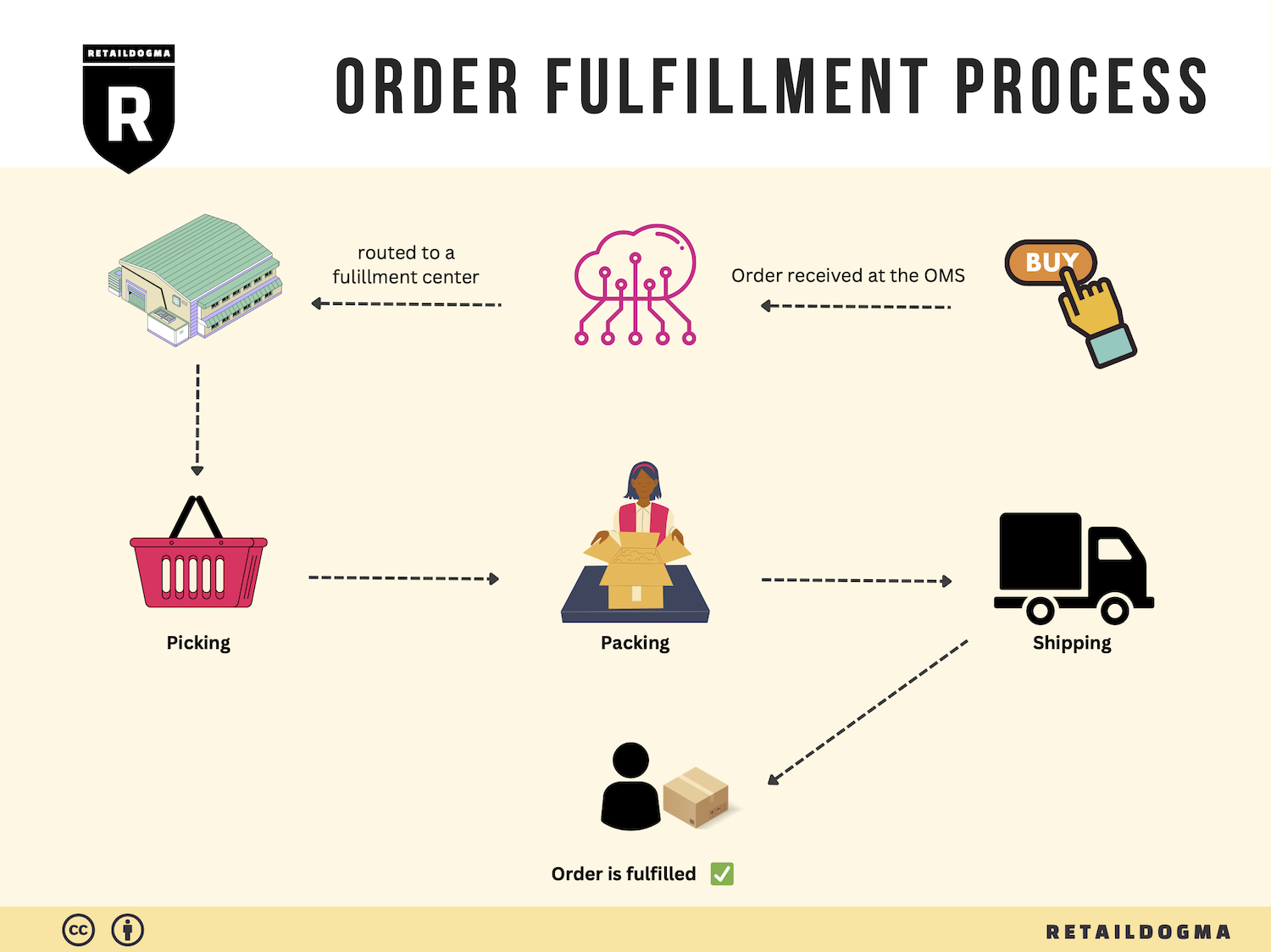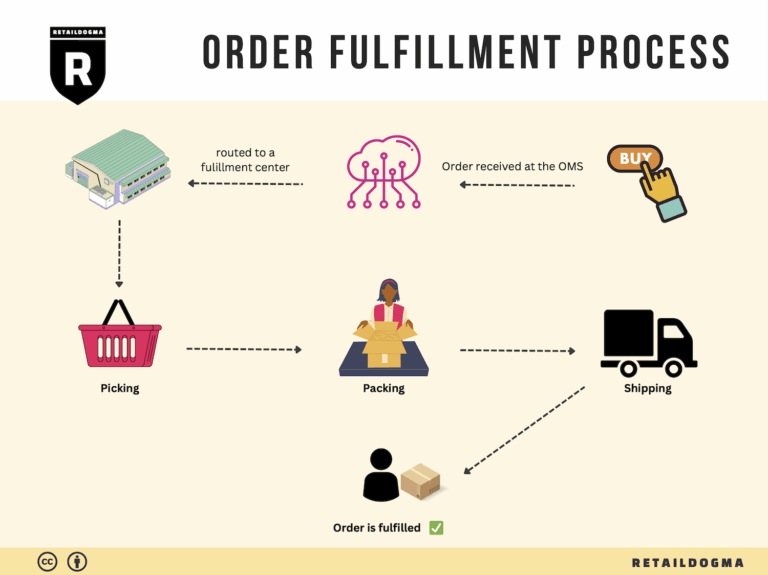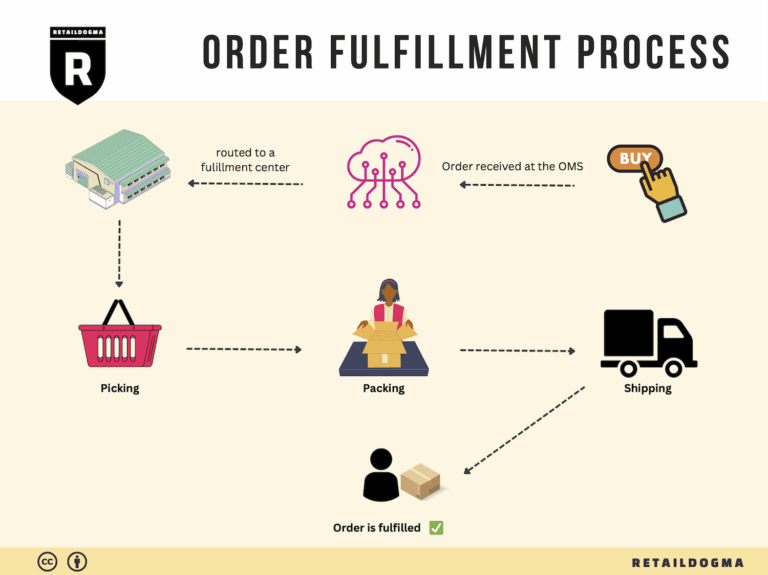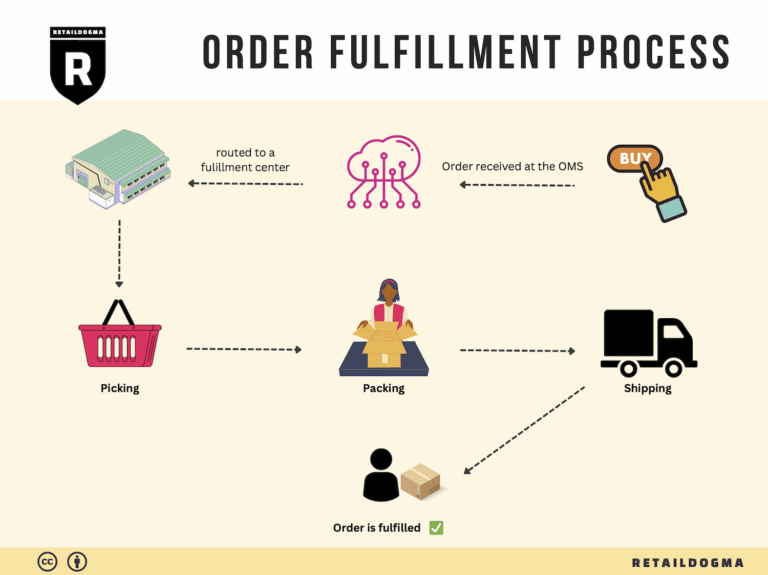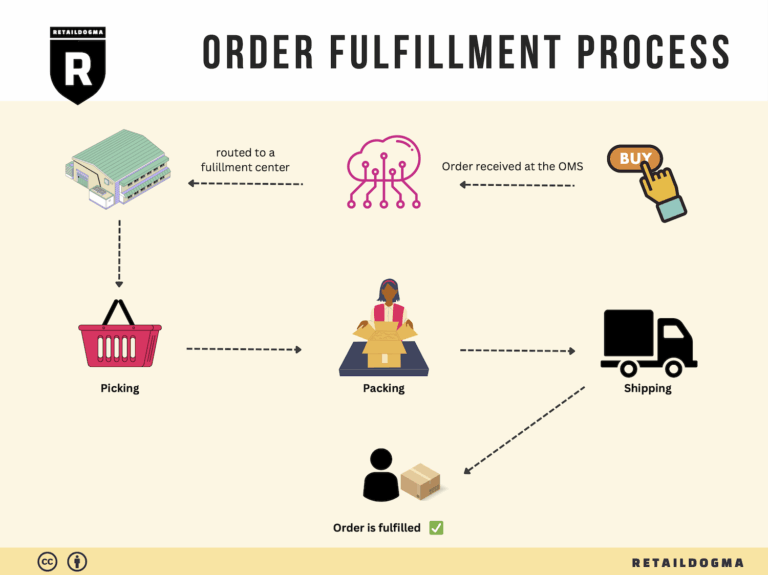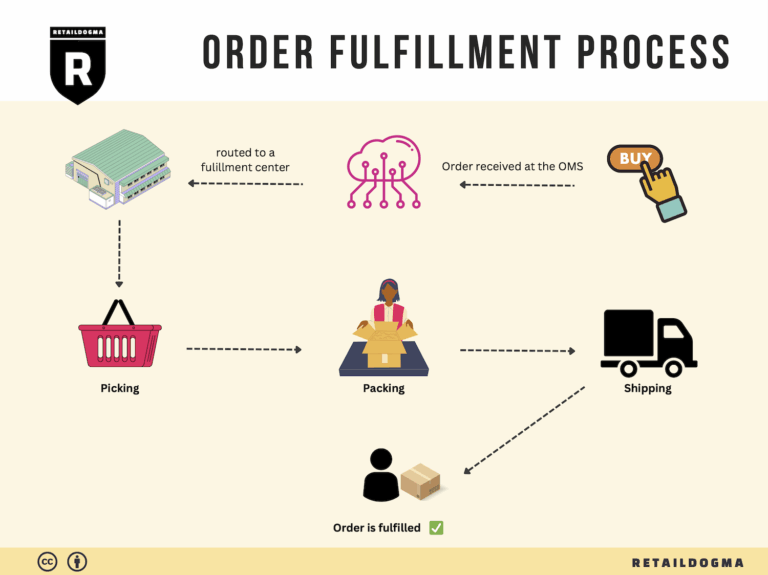Ecommerce Fulfillment Services: The Ultimate Guide (2025)
What is E-commerce Fulfillment? An Introduction for Growing Businesses
Running a growing e-commerce business can be exhilarating, but it often comes with the daunting challenge of managing order fulfillment. As sales increase, so do the demands of packing and shipping orders, which can quickly overwhelm even the most dedicated entrepreneurs. The fulfillment process—getting products from your warehouse to your customers—is critical to maintaining customer satisfaction and ensuring repeat business. If not handled efficiently, it can lead to delays, errors, and ultimately, unhappy customers.
Understanding Fulfillment in E-commerce
E-commerce fulfillment encompasses all the steps required to deliver a product to a customer after an order is placed. This includes receiving inventory, processing orders, picking and packing items, shipping them, and managing returns. For many businesses, fulfillment can be a complex web of logistics that requires careful planning and execution.
What This Guide Covers
In this guide, we will explore various fulfillment models that can help streamline your operations. You’ll learn about Third-Party Logistics (3PL) providers and Fulfillment by Amazon (FBA), each offering distinct advantages depending on your business needs. Understanding these models will empower you to choose the right path for your business.
Additionally, we’ll dive into the core services that fulfillment partners typically offer, such as inventory management, order processing, and shipping solutions. These services are crucial for maintaining efficiency and ensuring that your customers receive their orders on time.
Choosing the right fulfillment partner is another critical aspect we will cover. Factors such as reliability, technology integration, and scalability can significantly impact your operations. We will provide practical tips on how to evaluate potential partners and what questions to ask to ensure they align with your business goals.
Pricing is an essential consideration in fulfillment. We will discuss various pricing structures you might encounter, helping you to make informed decisions that balance cost with service quality.
The Goal of This Guide
Our goal is to empower your business with the knowledge necessary to make smart decisions about your logistics. By understanding the intricacies of e-commerce fulfillment, you can implement strategies that not only enhance efficiency but also improve customer satisfaction. In a competitive online marketplace, mastering your fulfillment process can be the difference between growth and stagnation. Let’s embark on this journey to simplify and optimize your e-commerce fulfillment strategy.

What You’ll Learn In This Guide
- What is E-commerce Fulfillment? An Introduction for Growing Businesses
- The Order Fulfillment Process: From ‘Buy’ Button to Customer’s Door
- Comparing Fulfillment Models: In-House vs. 3PL vs. Dropshipping
- A Deep Dive into Amazon FBA: Pros, Cons, and Who It’s For
- Core Services Offered by Fulfillment Centers
- How to Choose a Fulfillment Partner: A 6-Point Checklist
- Understanding Fulfillment Pricing: A Breakdown of Common Fees
- Frequently Asked Questions (FAQs) about Fulfillment
- Conclusion: Is Outsourcing Fulfillment the Right Move for Your Business?
- Important Disclaimer
The Order Fulfillment Process: From ‘Buy’ Button to Customer’s Door
1. Receiving Inventory
The order fulfillment process begins with receiving inventory, which is crucial for ensuring that the right products are available for order fulfillment. This step involves accepting goods from suppliers, checking delivery documents, and inspecting items for damage or discrepancies. A key term associated with this stage is SKU (Stock Keeping Unit), a unique identifier for each product that facilitates tracking and inventory management.
Why is this important? Accurate receiving ensures that your inventory levels are correct, which directly impacts your ability to fulfill customer orders. If discrepancies occur during this process, it can lead to stockouts or overstock situations, both of which can harm customer satisfaction and increase operational costs. Implementing a robust receiving process, including thorough checks and balances, will help maintain accurate inventory records and set the stage for efficient fulfillment.
2. Warehouse Storage
Once inventory is received and verified, the next step is warehouse storage. This involves organizing products within the warehouse in a manner that maximizes space efficiency and accessibility. Effective storage systems might employ various strategies, including ABC analysis, which categorizes inventory based on importance and turnover rates.
Why is this step significant? Proper warehouse storage reduces the time it takes to locate items during order picking, directly affecting the speed and efficiency of the overall fulfillment process. A well-organized warehouse minimizes the risk of errors and optimizes labor costs. For businesses looking to scale, investing in effective storage solutions—such as shelving systems, bins, and automated storage and retrieval systems—can enhance operational efficiency and support growth.
3. Order Picking
Order picking is the process of selecting items from inventory to fulfill customer orders. This step typically involves using pick lists, which detail the items and quantities needed for each order. Pick lists can be generated manually or automatically through an integrated warehouse management system (WMS).
Why is order picking important? This is often the most labor-intensive part of the fulfillment process and can significantly affect order accuracy and speed. Mistakes made during picking can lead to incorrect orders, resulting in returns and dissatisfied customers. To improve picking efficiency, businesses can implement strategies such as batch picking (picking multiple orders at once), zone picking (assigning specific areas of the warehouse to individual pickers), or using technology like barcode scanners to reduce errors.
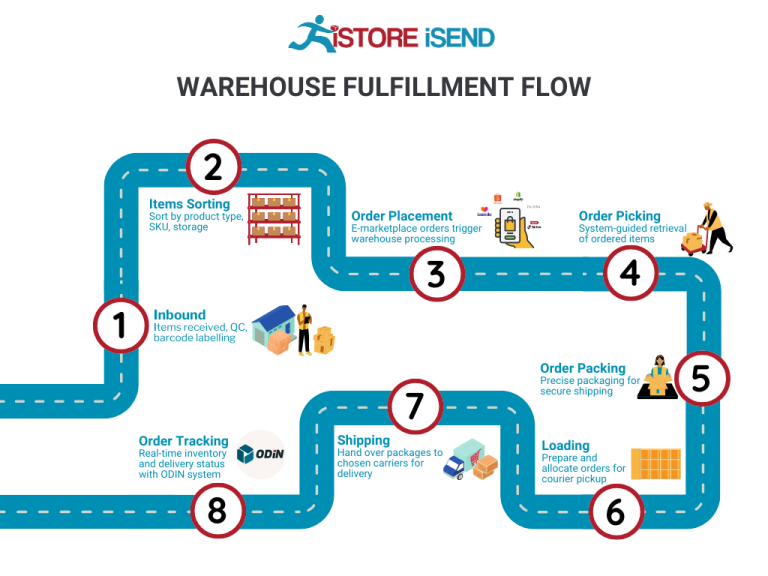
4. Order Packing
After items have been picked, they must be packed for shipment. This step involves placing the items into appropriate packaging, ensuring they are protected during transit, and preparing them for shipping. Key considerations include using the right packaging materials, such as boxes, bubble wrap, and packing peanuts, and generating shipping labels that comply with carrier requirements.
Why is packing crucial? Proper packing not only protects products but also impacts shipping costs and customer satisfaction. Efficient packing practices can reduce dimensional weight charges from carriers, while also enhancing the unboxing experience for customers. Businesses should consider investing in automated packing solutions or training staff on best practices to streamline this process, ensuring orders are packed quickly and accurately.
5. Shipping & Delivery
The final step in the order fulfillment process is shipping and delivery. This involves coordinating with shipping carriers to dispatch orders and track their journey to the customer’s door. Key terms associated with this step include lead time, which refers to the time taken from order placement to delivery, and last-mile delivery, the final step in the shipping process.
Why is shipping and delivery important? This stage is critical for customer satisfaction; delays or issues can lead to frustration and impact repeat business. Businesses must choose reliable shipping partners and continuously monitor delivery performance to improve service levels. Implementing a tracking system allows customers to stay informed about their order status, enhancing their overall experience. For scaling businesses, exploring options like dropshipping or regional fulfillment centers can help optimize shipping times and reduce costs.
By understanding and optimizing each step of the order fulfillment process, e-commerce businesses can enhance operational efficiency, improve customer satisfaction, and ultimately drive growth.
Comparing Fulfillment Models: In-House vs. 3PL vs. Dropshipping
Fulfillment Model Comparison
| Model | Who Handles Inventory | Best For (Business Stage) | Key Advantage | Key Disadvantage |
|---|---|---|---|---|
| In-House Fulfillment | The business itself | Established businesses with stable demand | Full control over inventory and operations | Higher operational costs and complexity |
| Third-Party Logistics (3PL) | A third-party provider | Growing businesses looking to scale | Flexibility and access to expertise | Less control over inventory and processes |
| Dropshipping | Supplier | Startups and businesses with limited capital | Low startup costs and no inventory risk | Lower profit margins and reliance on suppliers |
In-House Fulfillment
In-house fulfillment involves managing the entire order fulfillment process within the company’s own facilities. This model is best suited for established businesses with stable demand and a robust customer base. Companies that opt for in-house fulfillment maintain complete control over their inventory, allowing them to implement customized processes and quality control measures that align with their brand identity. This can lead to enhanced customer satisfaction, as businesses can ensure that orders are processed accurately and shipped promptly. However, the key disadvantage of in-house fulfillment is the higher operational costs associated with staffing, warehousing, and maintaining inventory. Additionally, businesses may face complexities related to space management, logistics, and technology integration, which can strain resources as they scale.
Third-Party Logistics (3PL)
Third-party logistics (3PL) providers offer a flexible solution for businesses looking to scale their operations without the burdens of managing fulfillment in-house. This model is particularly advantageous for growing businesses that experience fluctuating order volumes and seek to optimize their logistics operations. By partnering with a 3PL, businesses can leverage the provider’s expertise, technology, and infrastructure to manage warehousing, inventory, and shipping. Key advantages include scalability, reduced overhead costs, and the ability to focus on core business functions such as marketing and product development. However, the trade-off is a loss of control over inventory and fulfillment processes, which can lead to challenges in maintaining quality and consistency. Businesses must also ensure that their chosen 3PL aligns with their operational needs and customer expectations to avoid potential pitfalls.
Dropshipping
Dropshipping is a fulfillment model where the retailer does not hold inventory but instead transfers customer orders directly to a supplier, who then ships the products to the customer. This model is particularly well-suited for startups and entrepreneurs with limited capital, as it eliminates the need for upfront inventory investment and reduces financial risk. The key advantage of dropshipping is the low barrier to entry, allowing businesses to test new products and markets without significant financial commitments. However, dropshipping comes with its own set of challenges, including lower profit margins due to reliance on suppliers and potential delays in shipping that can affect customer satisfaction. Additionally, businesses may struggle with maintaining brand identity and quality control, as they have less oversight over the fulfillment process. As such, entrepreneurs must carefully select reliable suppliers and develop strong relationships to mitigate these risks.
Each fulfillment model offers unique advantages and disadvantages, and the right choice depends on the specific needs, stage, and goals of the business. Understanding these models is crucial for e-commerce business owners, operations managers, and entrepreneurs as they look to scale their sales and logistics effectively.
A Deep Dive into Amazon FBA: Pros, Cons, and Who It’s For
Understanding Fulfillment by Amazon (FBA)
Fulfillment by Amazon (FBA) is a service provided by Amazon that allows sellers to store their products in Amazon’s fulfillment centers. Amazon then takes care of storage, packaging, shipping, and customer service on behalf of the seller. This arrangement enables sellers to leverage Amazon’s extensive logistics network, ultimately improving their chances of success in the competitive e-commerce landscape.
How FBA Works
-
Registration and Setup: Sellers need to create an Amazon seller account and enroll in the FBA program. Once enrolled, they can list their products as FBA-eligible.
-
Inventory Preparation: Sellers prepare their products according to Amazon’s guidelines, which include labeling and packaging requirements. These guidelines ensure that products are easily identifiable and ready for efficient storage and shipment.
-
Shipping to Amazon: After preparing their products, sellers send their inventory to Amazon’s fulfillment centers. Amazon provides shipping plans to help sellers understand where to send their products.
-
Storage and Management: Once the products arrive at the fulfillment center, Amazon stores them until they are sold. Sellers can monitor their inventory levels through the Amazon Seller Central dashboard.
-
Order Fulfillment: When a customer places an order for an FBA product, Amazon handles the entire fulfillment process. This includes picking, packing, and shipping the product directly to the customer.
-
Customer Service and Returns: Amazon also manages customer service inquiries and handles returns for FBA products, which simplifies the process for sellers.
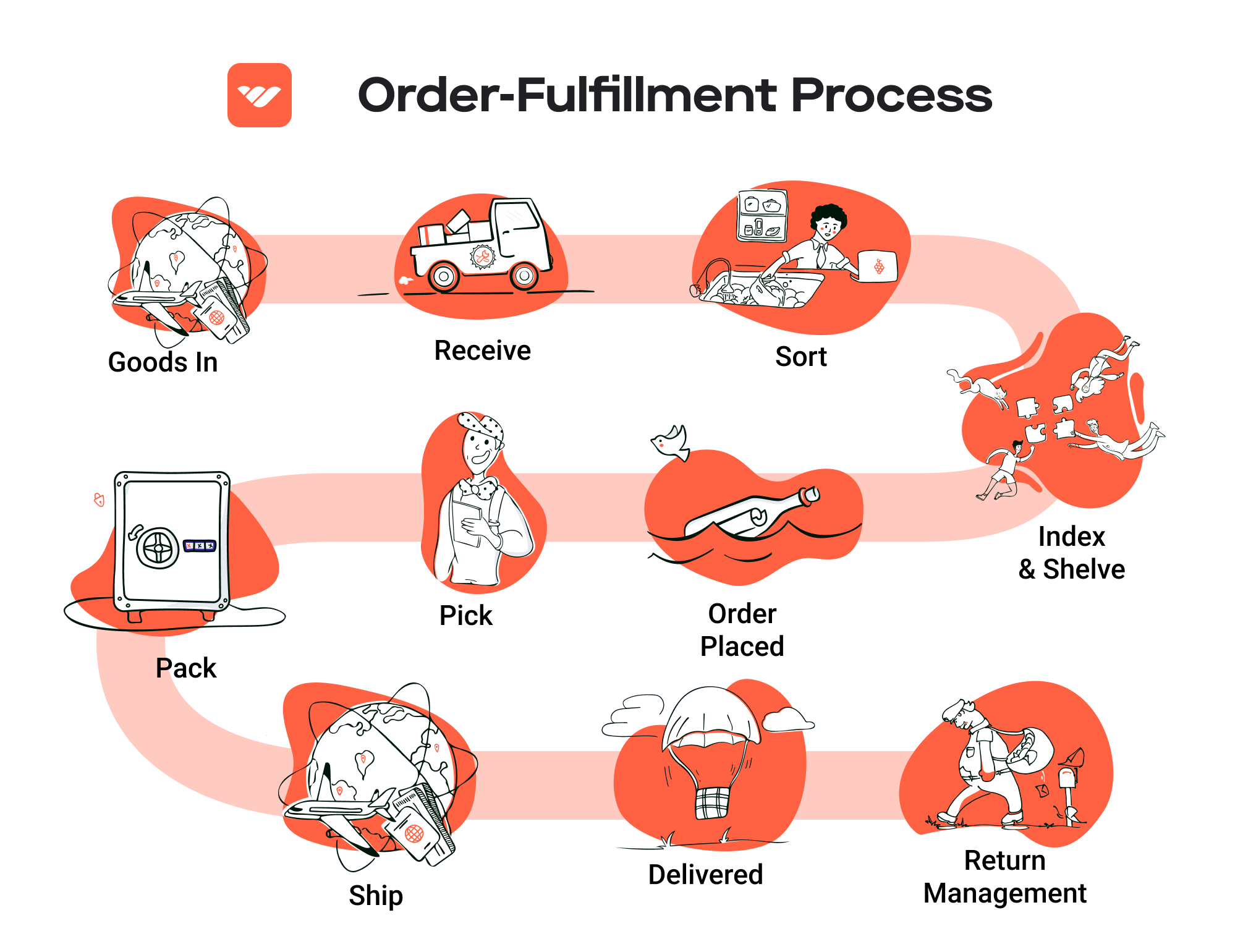
Pros of Using FBA
1. Prime Eligibility
One of the most significant advantages of using FBA is that it makes products eligible for Amazon Prime. Prime members often prefer products with the Prime badge due to the fast and free shipping options. This increased visibility can lead to higher sales volumes.
2. Customer Trust
Amazon is a trusted brand, and customers often feel more comfortable purchasing products fulfilled by Amazon. The assurance of reliable shipping and customer service provided by Amazon can enhance buyer confidence, potentially leading to increased sales.
3. Multi-Channel Fulfillment
FBA can be utilized for selling products beyond Amazon. Sellers can use FBA to fulfill orders from their own websites or other sales channels, allowing for a streamlined logistics process and inventory management.
4. Time Savings
By outsourcing fulfillment to Amazon, sellers can save significant time and resources that would otherwise be spent on warehousing, packing, and shipping. This enables them to focus on other aspects of their business, such as marketing and product development.
5. Scalable Solution
FBA offers a scalable solution for businesses of all sizes. As demand increases, sellers can easily send more inventory to Amazon without the need for significant investments in logistics infrastructure.
Cons of Using FBA
1. High Fees
While FBA offers many benefits, it also comes with various fees that can eat into profit margins. These include fulfillment fees, storage fees, and additional charges for long-term storage. Sellers must carefully calculate these costs to ensure profitability.
2. Strict Inventory Rules
Amazon has specific inventory management rules that sellers must adhere to. Non-compliance can lead to additional fees or even account suspension. Sellers need to maintain accurate inventory levels and follow Amazon’s guidelines to avoid penalties.
3. Commingling Risks
FBA products may be commingled with inventory from other sellers, meaning that sellers could receive returns that belong to another seller. This can create complications in managing inventory quality and tracking returns.
4. Limited Control
By using FBA, sellers relinquish some control over the fulfillment process. Amazon’s policies and practices govern how products are stored, packaged, and shipped, which may not align with a seller’s brand standards.
5. Potential for Stockouts
If a seller’s inventory runs low, it can lead to stockouts on Amazon. This can negatively impact sales and rankings, as customers may turn to competitors for similar products.
Who is FBA Best For?
Fulfillment by Amazon is particularly well-suited for:
-
Small to Medium-Sized Businesses: Businesses looking to scale quickly can benefit from Amazon’s vast infrastructure without the need for significant upfront investment in logistics.
-
E-commerce Entrepreneurs: Individuals launching new products can leverage FBA to minimize operational burdens while they focus on marketing and sales strategies.
-
Brands Seeking Exposure: Companies aiming to increase their visibility on Amazon and tap into the Prime customer base will find FBA advantageous.
-
Multi-Channel Sellers: Brands that sell on multiple platforms can streamline operations by utilizing FBA for fulfillment across different channels.
In conclusion, while Fulfillment by Amazon offers numerous advantages that can significantly enhance an e-commerce business’s operational efficiency and sales potential, it is crucial for sellers to weigh these benefits against the associated costs and risks. Careful consideration and strategic planning will enable sellers to make the most of this powerful fulfillment solution.
Core Services Offered by Fulfillment Centers
Inventory Management & Warehousing
Inventory management and warehousing are foundational services provided by fulfillment centers that enable e-commerce businesses to effectively control their stock levels, manage product storage, and ensure timely order fulfillment. Fulfillment centers utilize advanced inventory management systems that track stock quantities, movements, and sales patterns in real-time.
Benefits:
1. Optimized Stock Levels: By maintaining accurate inventory records, fulfillment centers help businesses avoid stockouts and overstock situations. This optimization leads to improved cash flow and reduced carrying costs.
-
Space Efficiency: Fulfillment centers are designed to maximize storage space through strategic layout and organization. This allows businesses to store a larger variety of products without the need for a dedicated warehouse, saving on real estate costs.
-
Scalability: As e-commerce businesses grow, fulfillment centers can adjust storage capacity to accommodate increased inventory levels, making it easier to scale operations without significant upfront investment.
-
Data Insights: Advanced reporting tools provide businesses with valuable insights into inventory turnover rates and trends, aiding in demand forecasting and informed purchasing decisions.
Pick and Pack Services
Pick and pack services involve the process of selecting items from inventory (picking) and packaging them for shipment (packing) based on customer orders. This service is critical for ensuring that products are accurately assembled and dispatched to customers in a timely manner.
Benefits:
1. Accuracy and Speed: Fulfillment centers employ trained associates and automated systems to ensure that orders are picked accurately and efficiently. This reduces the likelihood of errors that can lead to customer dissatisfaction and returns.
-
Customization Options: Many fulfillment centers offer customizable packaging solutions, allowing businesses to present their products in a branded manner that enhances customer experience and retention.
-
Increased Order Volume Handling: With dedicated pick and pack teams, fulfillment centers can handle large volumes of orders, especially during peak seasons, without compromising service quality.
-
Improved Shipping Times: Efficient pick and pack processes lead to faster order processing times, which is critical in today’s e-commerce landscape where customers expect rapid delivery.
Kitting and Assembly
Kitting and assembly services involve the grouping of multiple products into a single package or the assembly of products before they are shipped. This service is particularly useful for businesses offering complex products or bundled offers.
Benefits:
1. Enhanced Product Offerings: By combining products into kits, businesses can create attractive bundles that encourage higher average order values and can differentiate themselves from competitors.
-
Streamlined Operations: Outsourcing kitting and assembly to fulfillment centers allows e-commerce businesses to focus on core activities such as marketing and customer service, while experts handle the logistics.
-
Quality Control: Fulfillment centers often have quality assurance processes in place to check kits and assembled products before they are dispatched, reducing the chances of errors and improving customer satisfaction.
-
Flexibility: Fulfillment centers can adapt to changes in demand for specific kits or products, allowing businesses to quickly respond to market trends without the need for significant operational changes.
Returns Management (Reverse Logistics)
Returns management, or reverse logistics, refers to the processes involved in handling returned products. Fulfillment centers play a crucial role in managing returns efficiently, which is essential for maintaining customer satisfaction and brand loyalty in e-commerce.
Benefits:
1. Streamlined Process: Fulfillment centers can handle returns processing, including inspection, restocking, and inventory updates, which simplifies the return experience for customers and businesses alike.
-
Data Insights for Improvement: By analyzing return data, fulfillment centers can provide businesses with insights into why products are being returned, allowing them to make necessary adjustments to product offerings or descriptions.
-
Cost Reduction: Efficient returns management minimizes the costs associated with processing returns, including labor and shipping expenses. This is vital in maintaining profitability in an environment where returns can significantly impact margins.
-
Improved Customer Experience: A hassle-free return process enhances customer satisfaction, leading to repeat business and positive reviews. Fulfillment centers can provide pre-paid return labels and prompt processing, ensuring customers feel valued.
By leveraging these core services offered by fulfillment centers, e-commerce businesses can optimize their logistics operations, enhance customer satisfaction, and position themselves for scalable growth. Each service not only addresses specific operational needs but also contributes to the overall efficiency and effectiveness of the e-commerce supply chain.
How to Choose a Fulfillment Partner: A 6-Point Checklist
Location & Warehouse Network
Importance:
The location of your fulfillment partner’s warehouses can significantly affect shipping times and costs. Proximity to your customer base can lead to quicker delivery and lower shipping expenses, which are critical for maintaining customer satisfaction.
Questions to Ask:
– How many fulfillment centers do you operate, and where are they located?
– Can you provide a map showing your warehouse network?
– How do you handle shipping to remote areas or international destinations?
– What are your average shipping times to major metropolitan areas?
Technology & Integrations
Importance:
A robust technology platform enables seamless order processing, inventory management, and tracking. Your fulfillment partner should offer integrations with your existing e-commerce systems to ensure a smooth workflow.
Questions to Ask:
– What technology do you use for inventory management, order processing, and shipping?
– Can your system integrate with popular e-commerce platforms (e.g., Shopify, Magento, WooCommerce)?
– Do you provide real-time tracking for both inventory and orders?
– How do you handle system updates and potential downtime?
Specializations (e.g., Cold Storage, Oversized Items)
Importance:
Different businesses have unique requirements. If you sell products that require special handling, such as perishables or oversized items, your fulfillment partner must have the capabilities to manage these efficiently.
Questions to Ask:
– Do you have experience handling specific product types relevant to my business (e.g., cold storage for food items, oversized products)?
– What specialized equipment or processes do you have in place for these items?
– Can you provide case studies or references from similar clients?
– How do you manage quality control for specialized products?
Scalability & Capacity
Importance:
As your business grows, your fulfillment needs will change. Your partner must be able to scale operations in line with your growth, whether that means handling increased order volumes or expanding warehouse space.
Questions to Ask:
– How do you handle peak seasons or sudden spikes in order volume?
– What is your current capacity, and how quickly can you scale up if needed?
– Are there limitations on the types of products you can store or fulfill?
– Can you provide examples of how you’ve managed scaling for other clients?
Pricing and Contracts
Importance:
Understanding the pricing structure and contract terms is crucial for budgeting and financial planning. Hidden fees can lead to unexpected costs, so clarity is essential.
Questions to Ask:
– Can you provide a detailed breakdown of your pricing structure?
– Are there additional fees for services like returns, storage, or special handling?
– What is the length of the contract, and what are the termination terms?
– How often do you adjust your pricing, and how are clients notified?
Customer Support & Reviews
Importance:
Reliable customer support can make a significant difference in your fulfillment operations. A partner that is responsive and helpful can quickly resolve issues that arise, minimizing disruptions.
Questions to Ask:
– What customer support channels do you offer (e.g., phone, email, chat)?
– What are your response times for support inquiries?
– Can you provide references or testimonials from current or past clients?
– How do you handle disputes or service failures?
Conclusion
Choosing the right fulfillment partner is a critical decision that can impact your business’s efficiency, customer satisfaction, and ultimately, your bottom line. By following this checklist and asking the right questions, you can ensure that you select a partner who aligns with your operational needs and supports your growth ambitions. Remember, a thorough evaluation of potential partners will set the foundation for a successful and scalable fulfillment strategy.
Understanding Fulfillment Pricing: A Breakdown of Common Fees
Initial Setup Fees
Initial setup fees are one-time charges associated with onboarding a new client to a fulfillment center’s services. These fees can vary widely based on the complexity of the integration, the number of SKUs (Stock Keeping Units) that need to be processed, and the technology required for order management. Typically, you might encounter fees for:
- System Integration: Costs related to connecting your e-commerce platform with the fulfillment provider’s systems.
- Training: Charges for training your staff on how to use the fulfillment center’s systems and processes.
- Inventory Setup: Fees for creating and entering your inventory into the fulfillment center’s system.
To calculate these fees, providers often assess the scope of work required during the onboarding process, which can include time spent on system setup and the number of SKUs being managed. Be sure to request a detailed breakdown of these fees to avoid unexpected costs.
Receiving Fees
Receiving fees are charged when your inventory arrives at the fulfillment center. These fees cover the labor and resources required to unload, inspect, and store your products. The calculation of receiving fees typically depends on:
- Volume of Inventory: The more products you send, the higher the total receiving fee, as it often includes a per-pallet or per-box charge.
- Condition of Goods: If your products require special handling or inspection, additional fees may apply.
For example, a fulfillment center may charge a flat fee for receiving a truckload of goods or a variable fee based on the number of pallets received. It’s essential to clarify these rates upfront, especially if you anticipate fluctuating inventory levels.
Storage Fees (per pallet/bin)
Storage fees are recurring charges for storing your inventory at the fulfillment center. These fees can be calculated based on:
- Space Utilization: Charges are often assessed per pallet or bin, with the total fee determined by the amount of space your products occupy.
- Duration of Storage: Some fulfillment centers implement tiered pricing based on how long inventory is stored, with higher rates for longer durations.
For instance, a provider might charge $20 per pallet per month. If your inventory requires 10 pallets, your monthly storage fee would amount to $200. To optimize costs, consider regularly reviewing inventory levels and rotating stock to prevent long-term storage charges.
Pick & Pack Fees (per item/order)
Pick and pack fees are charged for the labor involved in retrieving items from storage and preparing them for shipment. These fees can vary significantly based on several factors:
- Complexity of Orders: Simple orders may incur lower fees compared to complex orders that require multiple items or special packaging.
- Volume of Orders: Some fulfillment centers offer discounts for higher order volumes, while others may charge a flat fee regardless of order complexity.
Typically, a fulfillment center may charge a fee per item picked and packed, e.g., $1.50 per item. If a customer orders three items, the total pick and pack fee would be $4.50. To minimize these costs, consider consolidating orders or using more efficient packaging solutions.
Shipping Fees
Shipping fees are the costs associated with transporting your products from the fulfillment center to the customer. These fees can be influenced by:
- Shipping Method: Options range from standard ground shipping to expedited shipping, with costs varying accordingly.
- Destination: Shipping to remote areas may incur additional charges, while bulk shipping to nearby locations may reduce costs.
- Carrier Discounts: Some fulfillment centers have partnerships with carriers that may offer discounted rates.
Shipping fees are usually calculated based on weight, dimensions, and destination. For example, a fulfillment center might charge a flat rate for packages under a certain weight and additional fees for heavier packages. It’s crucial to understand the shipping options available and their associated costs to provide accurate delivery estimates to customers.
Conclusion: Tips for Getting an Accurate Quote
To obtain an accurate quote for fulfillment services, consider the following tips:
- Define Your Needs: Clearly outline your business’s fulfillment requirements, including the types of products, order volume, and shipping preferences.
- Request Detailed Quotes: Ask for itemized quotes that break down each fee type to understand the overall costs.
- Negotiate Terms: Don’t hesitate to negotiate pricing, especially if you expect high order volumes or long-term partnerships.
- Compare Multiple Providers: Get quotes from several fulfillment centers to assess pricing and service offerings comprehensively.
- Evaluate Hidden Costs: Inquire about any additional fees that may not be included in the initial quote, such as return processing or special handling fees.
By being informed and proactive in discussions with fulfillment providers, you can better manage costs and ensure a successful partnership that supports your business’s growth.
Frequently Asked Questions (FAQs) about Fulfillment
1. What is an order fulfillment associate?
An order fulfillment associate is responsible for processing customer orders in an e-commerce environment. Their tasks typically include picking items from inventory, packing them securely, and preparing them for shipment. They ensure that orders are accurate and meet quality standards before dispatching to customers.
2. What skills are essential for an order fulfillment associate?
Key skills for an order fulfillment associate include attention to detail, organizational abilities, physical stamina (as the role often requires standing for long periods and lifting packages), basic computer skills for inventory management, and effective communication skills to coordinate with team members and address any issues that arise.
3. How does order fulfillment differ from warehousing?
While warehousing involves storing goods, order fulfillment encompasses the entire process of receiving, processing, and delivering customer orders. A fulfillment center is designed specifically for this purpose, integrating inventory management, order processing, and shipping operations, whereas a traditional warehouse may focus solely on storage.
4. What is a 3PL (Third-Party Logistics) provider?
A 3PL provider offers outsourced logistics services, including order fulfillment, warehousing, inventory management, and shipping. By partnering with a 3PL, e-commerce businesses can leverage the provider’s expertise and infrastructure, allowing them to focus on core business activities while improving efficiency and scalability in their logistics operations.
5. How much do fulfillment services cost?
Fulfillment service costs can vary widely based on factors such as order volume, storage space required, and additional services like packaging and shipping. On average, businesses may pay anywhere from $2 to $5 per order for fulfillment services, plus storage fees that can range from $10 to $40 per pallet per month. It’s essential to evaluate different providers and consider their pricing models to find a solution that fits your budget.
6. What technology is commonly used in order fulfillment?
Order fulfillment relies on various technologies, including warehouse management systems (WMS), inventory management software, barcode scanners, and automated picking systems. These tools help streamline operations, track inventory levels in real-time, and improve order accuracy, leading to faster processing times and enhanced customer satisfaction.
7. How can I improve my order fulfillment process?
To enhance your order fulfillment process, consider implementing the following strategies:
– Automate repetitive tasks using technology to reduce errors and speed up operations.
– Optimize your warehouse layout for efficient picking and packing.
– Train staff regularly to ensure they are familiar with best practices.
– Monitor key performance indicators (KPIs) such as order accuracy and turnaround times to identify areas for improvement.
8. What are the typical working conditions for an order fulfillment associate?
Order fulfillment associates often work in warehouse environments, which can be physically demanding. Associates may be required to stand for long periods, lift heavy items (up to 40 pounds), and operate machinery such as forklifts. The work environment can also be noisy due to machinery and equipment in use, necessitating proper safety measures and equipment.
9. What are some common challenges in order fulfillment?
Common challenges in order fulfillment include managing inventory effectively, ensuring order accuracy, handling peak seasons or spikes in demand, and dealing with shipping delays. To mitigate these issues, businesses can invest in robust inventory management systems, maintain clear communication with shipping partners, and implement contingency plans for high-demand periods.
10. How can I scale my order fulfillment operations?
Scaling order fulfillment operations requires strategic planning. Consider the following approaches:
– Evaluate your current fulfillment processes and identify bottlenecks.
– Invest in technology to automate and streamline operations.
– Partner with a reliable 3PL provider to expand your logistics capabilities.
– Increase your workforce during peak times with temporary staff or flexible scheduling solutions to meet demand without sacrificing service quality.
By addressing these aspects, you can effectively scale your order fulfillment operations to meet growing customer needs.
Conclusion: Is Outsourcing Fulfillment the Right Move for Your Business?
Evaluating the Benefits of Outsourcing Fulfillment
Outsourcing your order fulfillment can be a game-changer for your e-commerce business. By leveraging a specialized fulfillment service, you can save significant time and resources, allowing you to focus on strategic growth and customer engagement. Fulfillment partners streamline the picking, packing, and shipping processes, ensuring that orders are processed efficiently and accurately. This not only enhances customer satisfaction but also improves your operational efficiency.
Scalability is another critical advantage of outsourcing fulfillment. As your business grows, a capable fulfillment partner can easily adapt to increased order volumes, seasonal fluctuations, and diverse product lines. This flexibility allows you to respond swiftly to market demands without the burden of managing additional logistics and warehousing on your own.
Additionally, fulfillment services bring expertise that can enhance your overall operations. They often have access to advanced technology, industry best practices, and experienced personnel who can optimize your shipping processes, reducing errors and costs. This expertise can also provide insights into inventory management and shipping strategies, further driving your business’s success.
However, choosing the right fulfillment partner is crucial. Not all providers are created equal, and the right fit will depend on your specific business needs, product types, and customer expectations. It’s essential to conduct thorough research, request references, and evaluate potential partners based on their capabilities and alignment with your growth objectives.
Take Action
To determine if outsourcing fulfillment is the right next step for your business, consider conducting a thorough audit of your current shipping processes. Assess your operational challenges, fulfillment costs, and customer feedback. This introspection will provide clarity on whether a fulfillment partner can help you scale effectively and enhance customer satisfaction. Don’t hesitate to reach out to potential partners for consultations or proposals, as this can provide valuable insights into how they can support your business’s growth.
Important Disclaimer
⚠️ Important Disclaimer
The information in this guide is for educational purposes. Fulfillment services, pricing, and platform features change frequently. Always conduct your own due diligence and consult with providers directly before making business decisions.
